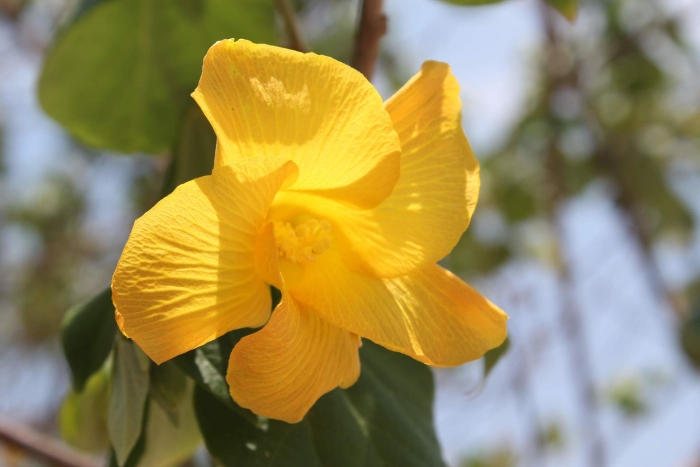Sea Hibiscus
(Talipariti tiliaceum)
Sea Hibiscus (Talipariti tiliaceum)
/
/

Viacheslav Shalisko
CC BY 4.0
Image By:
Viacheslav Shalisko
Recorded By:
Copyright:
CC BY 4.0
Copyright Notice:
Photo by: Viacheslav Shalisko | License Type: CC BY 4.0 | License URL: http://creativecommons.org/licenses/by/4.0/ | Rights Holder: Viacheslav Shalisko | Publisher: iNaturalist | Date Created: 2018-07-21T14:00:06-07:00 |





















Estimated Native Range
Summary
Talipariti tiliaceum, commonly known as Sea Hibiscus or Coast Cottonwood, is a deciduous tree native to coastal and near-coastal regions, often found in mangrove forests, beachfronts, and other saline environments. It is widely distributed in tropical areas, including parts of Central and South America, Africa, South Asia, Southeast Asia, East Asia, Australia, and many Pacific Islands. The tree typically reaches heights of 13-33 feet (4-10 meters) with a spreading canopy that provides light shade. The Sea Hibiscus is known for its bright yellow flowers with a deep red center, which bloom throughout the year in warmer climates. These flowers are quite showy, changing color to orange and red before falling, often within a single day.
The Sea Hibiscus is valued for its ability to withstand harsh coastal conditions, including salt spray and waterlogging. It is adaptable to a variety of soils, including quartz sand, coral sand, marl, and limestone. In cultivation, it is used for its ornamental value, particularly for its unique, color-changing flowers and attractive, heart-shaped leaves. It is also planted for erosion control and as a windbreak in coastal areas. The tree requires full sun to part shade and can tolerate a range of soil conditions, though it prefers well-drained soils. While it is generally pest-resistant, it can be susceptible to root rot in poorly drained soils. The wood is used for construction, firewood, and rope making, while the bark and roots have medicinal properties, traditionally used to treat fevers. In Hawaii, the wood was historically used for canoe spars and fishing net floats.CC BY-SA 4.0
The Sea Hibiscus is valued for its ability to withstand harsh coastal conditions, including salt spray and waterlogging. It is adaptable to a variety of soils, including quartz sand, coral sand, marl, and limestone. In cultivation, it is used for its ornamental value, particularly for its unique, color-changing flowers and attractive, heart-shaped leaves. It is also planted for erosion control and as a windbreak in coastal areas. The tree requires full sun to part shade and can tolerate a range of soil conditions, though it prefers well-drained soils. While it is generally pest-resistant, it can be susceptible to root rot in poorly drained soils. The wood is used for construction, firewood, and rope making, while the bark and roots have medicinal properties, traditionally used to treat fevers. In Hawaii, the wood was historically used for canoe spars and fishing net floats.CC BY-SA 4.0
Plant Description
- Plant Type: Trees
- Height: 10-30 feet
- Width: 10-25 feet
- Growth Rate: Moderate
- Flower Color: Orange, Yellow
- Flowering Season: Summer
- Leaf Retention: Evergreen
Growth Requirements
- Sun: Full Sun, Part Shade
- Water: Medium
- Drainage: Fast, Medium
Common Uses
Bee Garden, Bird Garden, Drought Tolerant, Erosion Control, Fragrant, Low Maintenance, Salt Tolerant, Showy Flowers, Street Planting
Natural Habitat
Coastal and near-coastal regions, often found in mangrove forests and beachfronts
Other Names
Common Names: Hawaiian Hibiscus , Cottontree , Mahoe , Majagua , Waru , Beach Hibiscus
Scientific Names: Talipariti tiliaceum , Abelmoschus guineensis , Hibiscus albovariegata , Hibiscus boninensis , Hibiscus circinnatus , Hibiscus elatus , Hibiscus guineensis , Hibiscus porophyllus , Hibiscus tiliaceus , Hibiscus tiliaceus f. albiflorus
GBIF Accepted Name: